RF Controls ITCSA100 RF ID Signal Acquisition & Source Location Unit User Manual SASL Installation Guide 0v93
RF Controls, LLC RF ID Signal Acquisition & Source Location Unit SASL Installation Guide 0v93
Contents
- 1. User Manual 1 of 3
- 2. User Manual 2 of 3
- 3. User Manual 3 of 3
User Manual 1 of 3
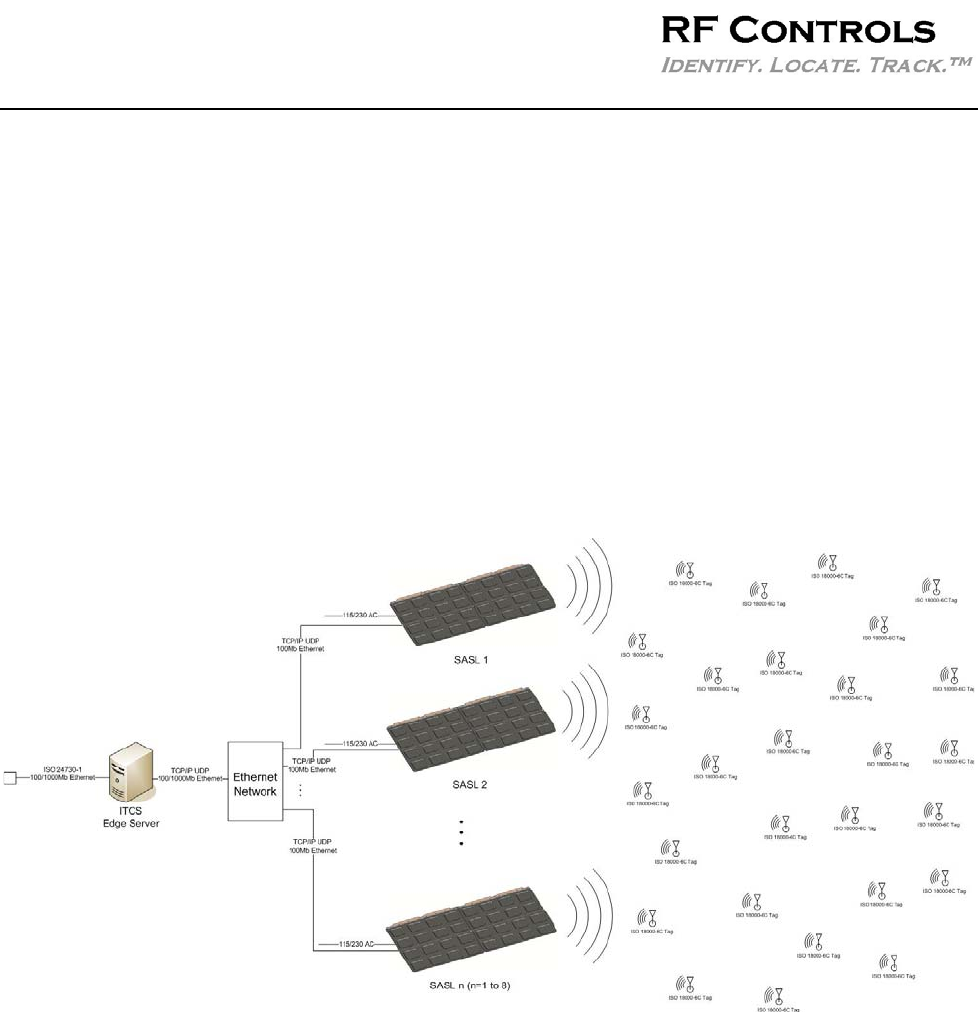
SASL Installation Guide V0.9 - Part # ITCS-A-100-001v0.93 1
User Guide
(provisional)
SASL™ (Signal Acquisition & Source Location unit)
RF Controls Intelligent Tracking and Control System (ITCS™)

SASL Installation Guide V0.9 - Part # ITCS-A-100-001v0.93 2
Introduction
This SASL™ User Guide provides the basic information needed to install and set up an individual
SASL antenna unit. This guide is not intended to provide instructions for installing, configuring and
calibrating the RF Controls Intelligent Tracking and Control System (ITCS™). Detailed instructions
are provided in the System Integrator Installation Manual and Programmer’s Reference Guide.
INTENDED AUDIENCE
This guide is intended for those who will install and set up the RF Controls SASL (Signal
Acquisition and Source Location) unit. Before attempting to install, configure and operate this
product, you should be familiar with the following:
• Windows based software installation and operation
• Device communication parameters including Ethernet and serial communications
• RFID reader configuration including antenna placement and RF Parameters
• Electrical and RF safety procedures.
CONTENTS
1. SASL overview
2. Installation
3. Software
4. Specifications
5. Safety instructions
FCC NOTICE
This device complies with part 15 of the FCC Rules. Operation is subject to the following two
conditions: (1) This device may not cause harmful interference, and (2) this device must accept any
interference received, including interference that may cause undesired operation.
CONTACT INFORMATION
RF Controls LLC
1141 S 7th Street
St. Louis
MO 63104-3623
USA
Phone: +1 314 5716200
Fax: +1 314 832 0029
Web site: http://www.rfctrls.com
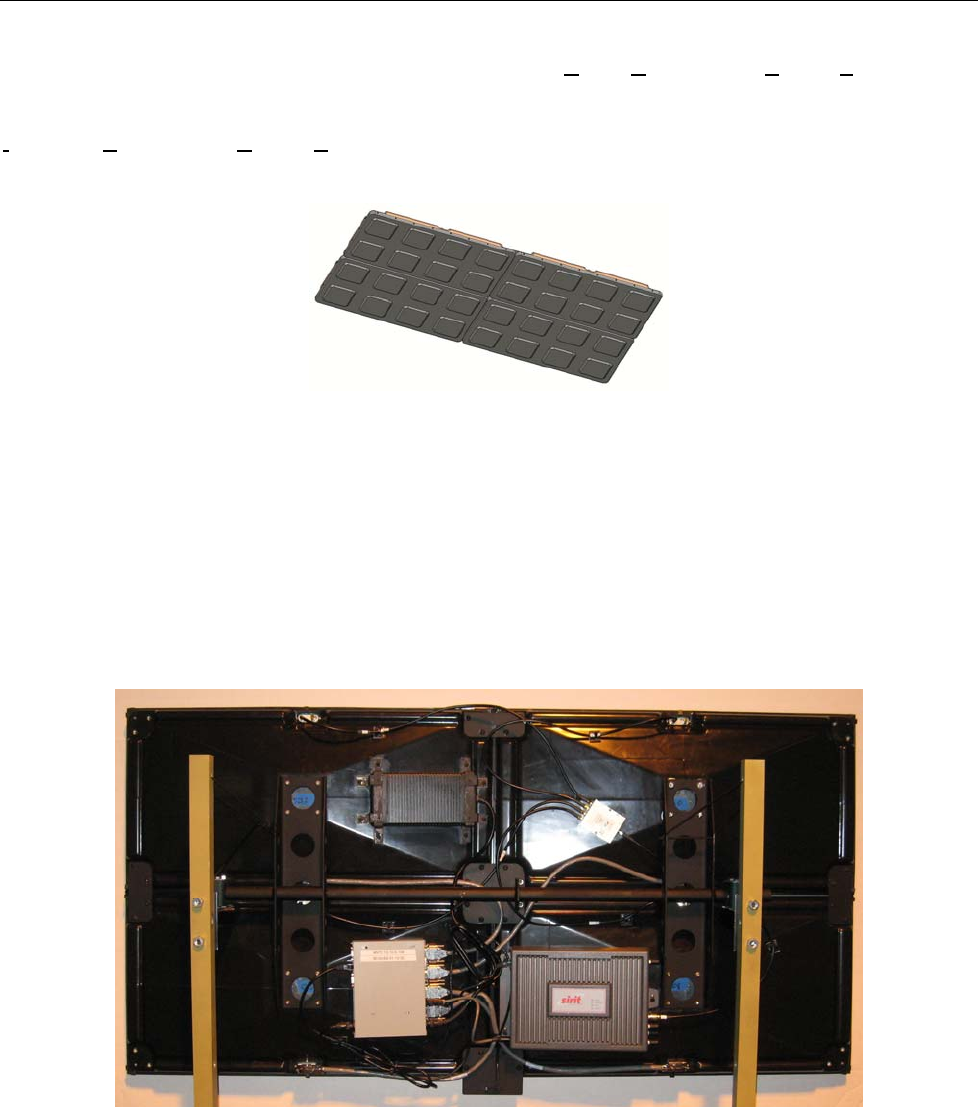
SASL Installation Guide V0.9 - Part # ITCS-A-100-001v0.93 3
SASL OVERVIEW
SASL is a multi-protocol, multi-regional Radio Frequency Signal Acquisition & Source Location unit,
which is used to Identify and locate RFID tags operating in the UHF 860 – 960 MHz frequency
band. A number of SASL units may be used together with an ITCS ‘Edge Server’ to form an
Intelligent Tracking and Control System (ITCS).
Figure 1
SASL (Signal Acquisition and Source Location unit)
SASL comprises an embedded multi-protocol, multi-regional RFID reader/writer transceiver
connected to the patented steerable phased array antenna system. SASL is designed to operate
from AC mains power in the range of 90 to 260 Volts AC 50/60Hz and communicates with a host
computer using standard Ethernet TCP/IP and UDP protocol. Figure 2 shows the rear view of the
SASL mounted on a support frame using “Unistrut® ” fasteners.
Figure 2:
SASL Rear View
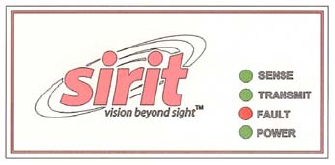
SASL Installation Guide V0.9 - Part # ITCS-A-100-001v0.93 4
INDICATOR LIGHTS
There are four lights on the back of the SASL located on the Sirit RFID reader.
The indicator lights on the Sirit RFID reader are:
• Sense – Indicates that the reader has detected a tag in the RF field
• Transmit – indicates that the reader/writer transmitter is operating (RF on)
• Fault – Indicates that there is a fault
• Power – Indicates that power is applied to the reader
Note that when the Sirit reader is performing power on auto-test, the indicator lights will flash
momentarily.
Figure 3
Sirit RFID Reader Indicator Lights.
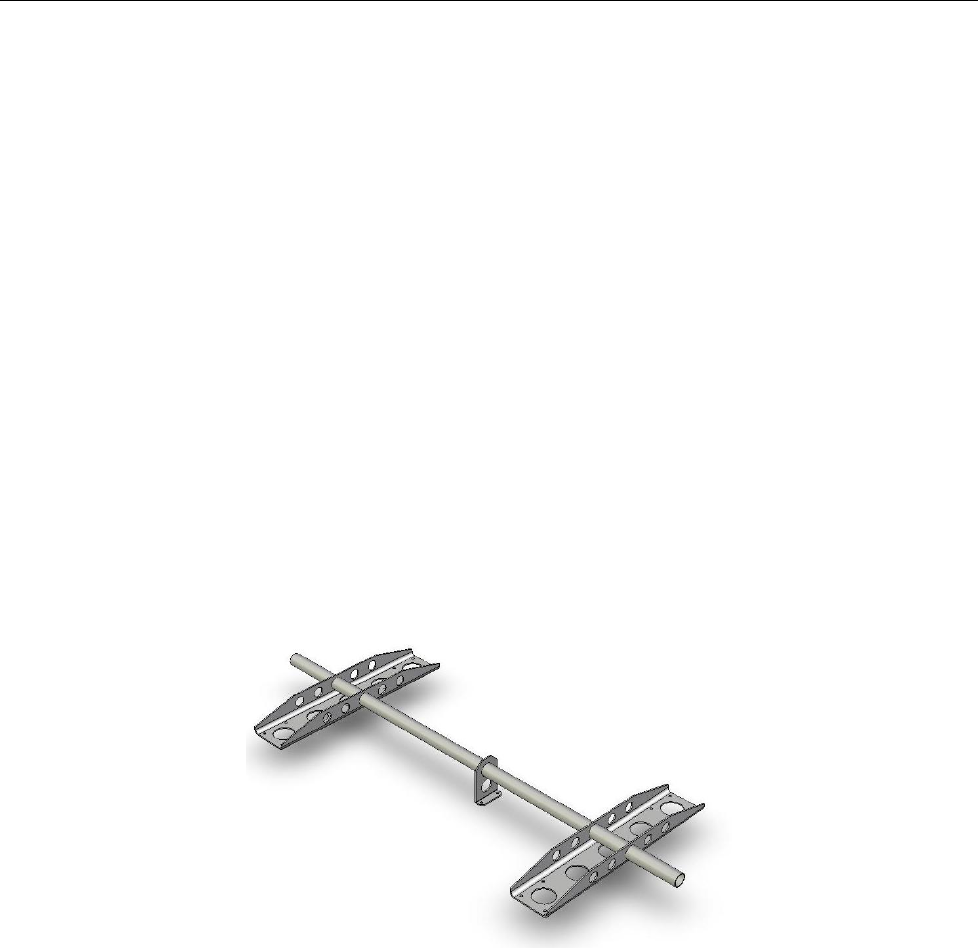
SASL Installation Guide V0.9 - Part # ITCS-A-100-001v0.93 5
Installation
MECHANICAL INSTALLATION
The SASL is provided in its standard configuration with a mounting bracket for installation in a
landscape orientation. An optional portrait mounting bracket is available if under special
circumstances an installation configuration requires the SASL to be installed in portrait orientation.
Contact a member of our technical support team for more information.
The SASL unit weighs 75 lbs (34 kg), so it is important to ensure that the structure, to which the
SASL is to be attached, is of sufficient strength.
The SASL may be ceiling mounted, wall mounted or attached to a suitable stand. When ceiling
mounted, a separate safety cable must be secured to a ceiling fixture and to one of the eyes the
SASL mounting bracket.
The SASL mounting bracket incorporates a mounting tube which is designed to be attached to
industry standard “UNISTRUT®” industrial framing systems. (See: www.unistrut.com for more
information). Figure 2 shows the SASL mounted on a frame.
When mounting the SASL as a stand-alone unit, make sure that it is mounted the correct way up as
indicated by the arrow on the back panel. If the SASL is one of several and is part of an ITCS
network, then orientate each SASL according to the ITCS system installation drawings. If in doubt
contact a member of our technical support team.
Figure 4
Mounting bracket.
SAFETY WARNING
The SASL weighs 75lbs (34kg) and should only be installed using suitable safety and lifting
equipment. Ensure that the wall fixings or mounting hardware is suitably rated.
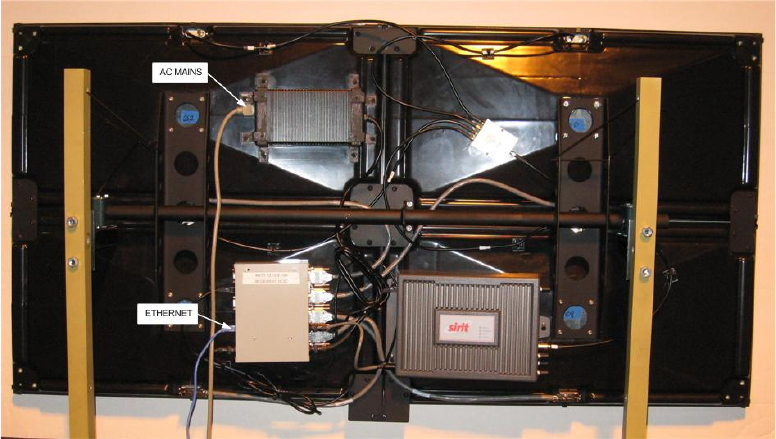
SASL Installation Guide V0.9 - Part # ITCS-A-100-001v0.93 6
ELECTRICAL INSTALLATION
Electrical installation requires the connection of two plugs.
AC Mains Input
AC mains input is provided on an IEC connector on the power supply module as shown in figure 5.
Connect the provided IEC mains cord to the power supply and plug it in to a suitable mains outlet.
Note that the mains outlet must be located in close proximity to the SASL and must be accessible
to enable easy disconnection of the mains supply to the SASL in case of emergency or when
servicing.
Ethernet
The Ethernet LAN connection uses the industry standard RJ-45 connector. A suitable Ethernet
cable fitted with an RJ-45 plug is connected to the SASL RAID processor box as shown in figure 5.
The SASL is factory programmed with a fixed IP address which is shown on the label adjacent to
the Ethernet connector.
Figure 5
Power and Ethernet Connections
WARNING
The interconnect wiring and cables on the rear of the SASL are factory installed and are not
intended to be field serviceable. The RF cables are specially tuned. Any tampering or
modification of these cables or connections will invalidate type approval and may seriously
compromise the device performance. Note that the connectors are fitted with tamper evident
seals.
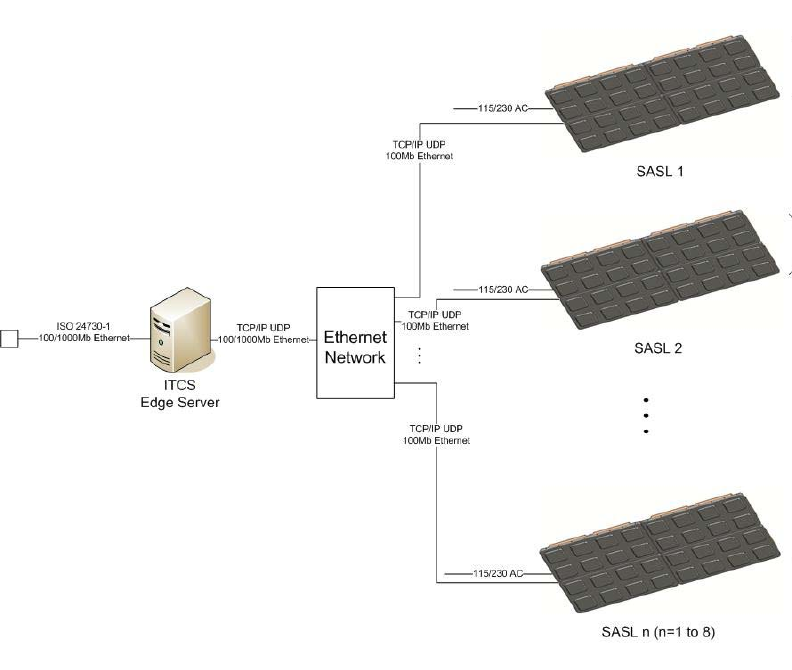
SASL Installation Guide V0.9 - Part # ITCS-A-100-001v0.93 7
MULTIPLE SASL UNITS CONFIGURED AS AN ITCS
Two or more SASL units may be connected via an Ethernet network to an ITCS Edge Server to
form an Intelligent Tracking and Control System. The diagram in figure 6 illustrates the basic
system architecture. The RF Controls System Integration Manual provides details on how to
install, configure and calibrate an ITCS. The Programmers Reference Guide provides details of
the Application Program Interface (API) used by the ITCS.
Figure 6
Intelligent Tracking and Control System comprising a number of SASL units connected via an
Ethernet Network to an ITCS Edge Server
NON IONIZING RADIATION
This unit incorporates a Radio Frequency Transmitter and should therefore be installed and
operated so as to avoid exposure of any persons to unsafe emissions. The FCC requires that any
antenna, which includes the SASL, be mounted so that a separation distance of at least 20cm is
provided from all persons. See FCC Radiation Exposure Statement in the Safety Instructions
section of this guide.
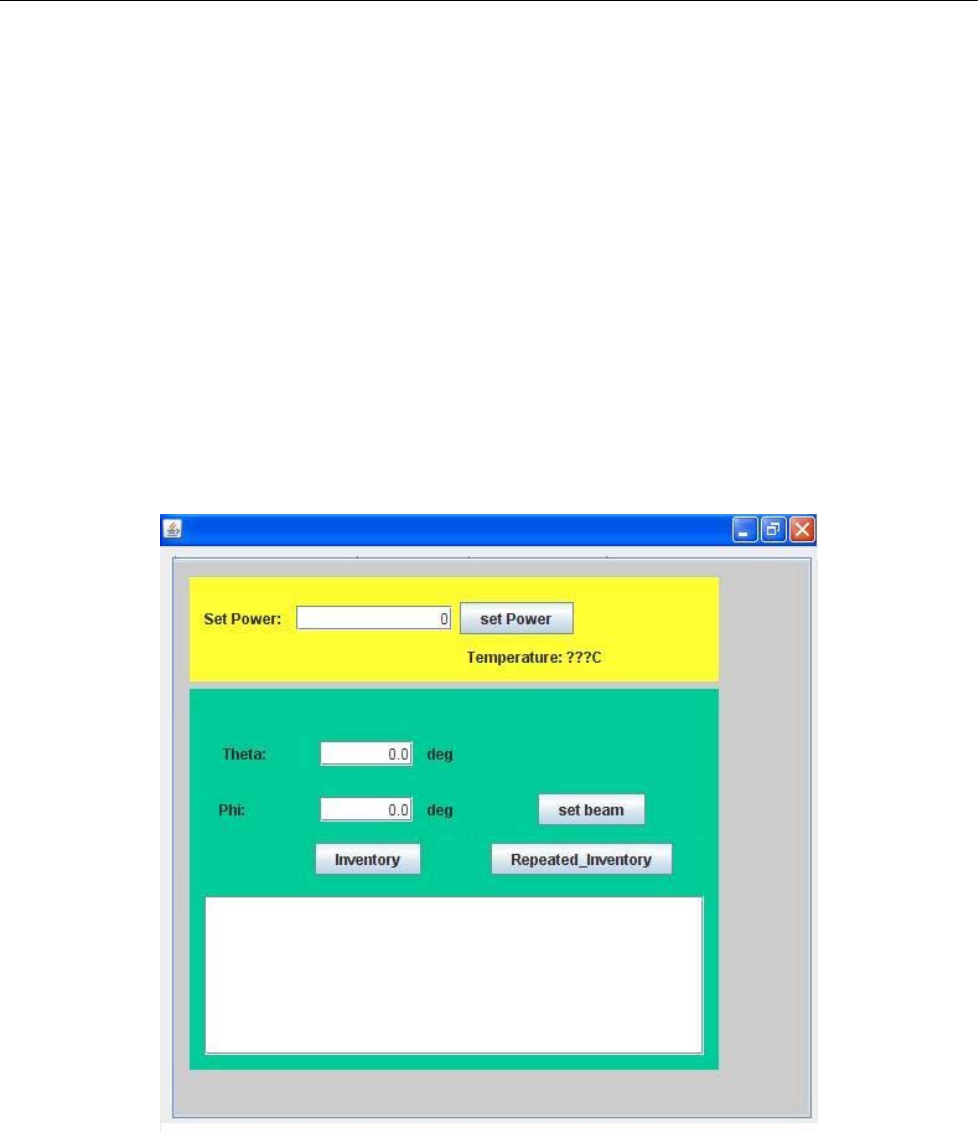
SASL Installation Guide V0.9 - Part # ITCS-A-100-001v0.93 8
Software
The SASL is provided with a basic test program on a CD, to run on a Microsoft™ Windows®
equipped Personal Computer. The program enables you to carry out a number of basic tests:
• Command the SASL to transmit
• Adjust the RF output power of the SASL as a percentage of maximum power. (Note: the
maximum output power is factory set to the maximum RF output power allowed for the
particular country of destination).
• Identify a tag by its UII number (EPC code in the case of EPC UHF Gen 2)
• Display the Received Signal Strength of each tag
• Display the Phi Φ and Theta θ values of the SASL beam direction.
The installation software should automatically install when the CD is inserted into the PC. If for any
reason it does not auto run, then browse for the setup.exe file on the installation CD and run it.
Once the program has been successfully installed it may be opened.
Figure 7 shows the basic test program control panel screen.
Figure 7
Test Program Control Panel Screen
SASL Installation Guide V0.9 - Part # ITCS-A-100-001v0.93 9
USING THE TEST PROGRAM
Set RF Output Power
Enter the desired RF output power as a percentage of the maximum power into the Set
Power box. Click the set Power button. (Note: the actual maximum Radiated RF Power is
factory set to comply with the radio regulations in the country of use. In the USA and
Canada this is 4 Watts EiRP).
Set Beam
The beam direction may be pointed to any desired direction within ± 30 degrees of a line
perpendicular to the centre of the SASL antenna panel. When looking in the direction of the
beam (as if through the SASL), and with the SASL orientated with the arrow upwards, Phi
+ve angles are up, -ve angles are down. Theta +ve is left and –ve is right. Enter the
steering angles Theta and Phi in the respective boxes and click set beam.
Read Tags
Click the Inventory button. Tag UII (EPC code) followed by the Received Signal Strength in
dBm will be shown in the window for each tag identified. If there is more than one tag, then
each tag identified will be shown on a separate line. Click the Repeated_Inventory button
to repeatedly query for tags present in the SASL beam. This function is useful for identifying
tags that are moving.
APPLICATION INTERFACE
The SASL uses an International Standard, Application Program Interface (API) as defined in
ISO/IEC 24730. Further details of the API and commands are contained in the Programmer’s
Reference Guide.

SASL Installation Guide V0.9 - Part # ITCS-A-100-001v0.93 10
Specifications
General
Frequency UHF band: 860 – 960 MHz *Note
RF Radiated Output Power Adjustable from 0.1 to 4 Watts EiRP
Regulatory Compliance FCC, CFR47 Part 15.247
Reading/writing Protocols ISO18000-6C / EPC UHF Gen 2
EM 4122 (TTO)
FCC ID WFQITCSA100
Application Interface ISO/IEC 24730
Environmental
Operating Temperature 0 to 60 deg C
Storage Temperature -40 to 85 deg C
Relative Humidity 5 to 95% non-condensing
Dimensions 64in x 32in x 6in (162.5 x 81.25 x 15.24 cm)
Weight 75 lbs (34 kg)
Ethernet LAN
Connector RJ-45
Ethernet 10/100 BaseT
Indicators Yellow – link operational
Green – network traffic detected
Signals Pin 1 TXD+
Pin 2 TXD -
Pin 3 RXD+
Pin 4 NC
Pin 5 NC
Pin 6 RXD -
Pin 7 NC
Pin 8 NC
Power Supply
Input Connector IEC/EN 60320
Voltage 90 – 265 Volts AC
Frequency 48 – 62 Hz
Consumption 90VA
Antenna
Gain Nominally 8.6dBi (depends on transmit frequency)
Polarization Circular
Note: The SASL uses the Sirit INfinity 510 RFID reader which is type approved for use in the USA, Canada,
Europe and many other countries. The specific operating frequency/s and transmit mode will be factory
set at time of shipping, to suit the country of installation and use.

SASL Installation Guide V0.9 - Part # ITCS-A-100-001v0.93 11
Safety Instructions
This unit emits Radio Frequency non-ionizing radiation. The installer must ensure that the antenna
is located or pointed such that it does not create an RF field in excess of that permitted by the
Health and Safety Regulations applicable to the country of installation.
FCC Radiation Exposure Statement
The antenna used on this equipment must be installed to provide a separation distance of at
least 20cm from all persons and must not be co-located or operated in conjunction with
another antenna or transmitter.
FCC Part 15 Notice
This device complies with part 15 of the FCC Rules. Operation is subject to the following two
conditions: (1) This device may not cause harmful interference, and (2) this device must accept any
interference received, including interference that may cause undesired operation.
Power Disconnect Device
The plug on the power supply cord is intended to be the power disconnect device. The power
source (socket or outlet) shall be located near the equipment and shall be easily accessible.
This product is protected by one or more US and International Patents pending.
The “RF Controls” logo, and the words “RF Controls, Identify, Locate, Track”, “ITCS” and
“SASL” are registered Trade Marks of RF Controls LLC.
RF Controls LLC
1141 S 7th Street
St. Louis
MO 63104-3623
USA
Phone: +1 314 571 6200
Fax: +1 314 832 0029
Web site: http://www.rfctrls.com